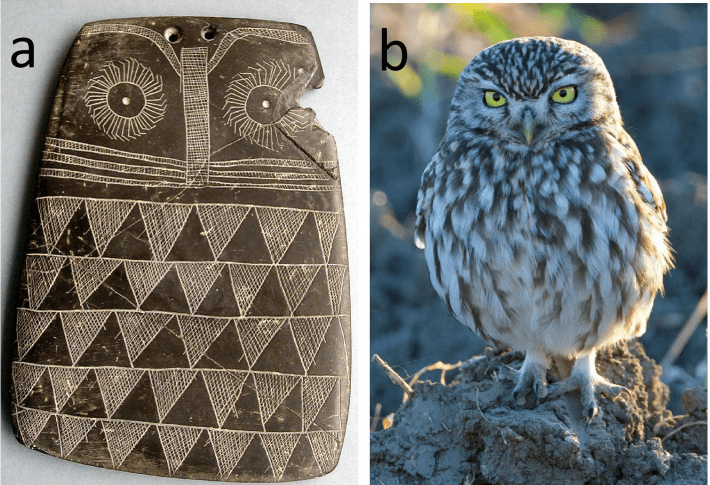Kids’ owl-drawing abilities don’t appear to have progressed much over the past five millennia, according to the findings of a new investigation into Copper Age animal engravings. Previously, these ancient owlish depictions had been interpreted as ritualistic artefacts, yet the “cartoonlike” nature of the etchings implies that they may actually have been toys created by and for children.
Several thousand engraved slate plaques resembling owls have been found in Copper Age burials across the Iberian Peninsula. And while archaeologists have debated the function of these carvings for over a century, most scholars favor the idea that they represented goddesses and were used in funerary rituals.
However, the authors of a new study challenge this theory by pointing out that the owl plaques appear too simple to have held such ceremonial importance.
For instance, they note that many ancient funerary objects of were crafted from “precious materials or rare rocks including gold, elephant ivory or rock crystal, which originated in distant areas sometimes hundreds of kilometers away from the site of discovery.” In contrast, slate was readily abundant in and around Iberian settlements, and would not therefore have been considered a valuable material.
Furthermore, they say that engraving on slate is easily done, and can be accomplished by even the most inexperienced craftsperson. “Plaque manufacture and design were simple and did not demand high skills nor intensive labor,” they explain, pointing to previous experiments in which untrained participants managed to recreate the plaques in just a few hours.
The rudimentary nature of the objects therefore led the researchers to suspect that they weren’t created by master artisans, but by children. After all, the availability of slate, combined with the fact that it is so easy to etch, makes it the perfect material for youngsters to practice drawing on.
“In some of the engraved plaques we see… a cartoonlike owl… as if conceived by a child,” they say.

To validate their theory, the study authors gathered 100 Copper Age owl plaques and rated their “owliness” based on how well they represented six different traits that are characteristic of the nocturnal birds. More specifically, the researchers looked for a flat facial disk, a beak, patterned feathers, two eyes, wings and feathery tufts.
While some of the plaques clearly depicted all of these features, others were somewhat loose in their owlish likeness. This led the researchers to wonder if the birds were drawn by children of different ages, with the younger artists producing more abstract-looking birds.
They therefore gathered a second set of 100 owl drawings that were created by modern-day children aged between four and 13. Using the same owl rating system to assess the sketches, the study authors found that those drawn by younger kids tended to include fewer of the six fundamental owl traits, while older children generally included all of these key features in their depictions.
“There is a progression related to age in the owliness of the depictions, with more and more owl characters added by older children,” write the researchers. This, they say, “may help explain at least partially why there are so many plaque types, and why some are more evocative of owls than others.”
Summing up their findings, the authors state that “owl engravings could have been executed by youngsters, as they resemble owls painted today by elementary school students.”
They therefore conclude that the plaques were probably intended for use during “playful activities”, and that some children may also have offered their owls as burial goods as a way of participating in group rituals.
The study has been published in the journal Scientific Reports.
Source Link: Adorable 5,000-Year-Old Owl Plaques May Have Been Toys For Copper Age Children